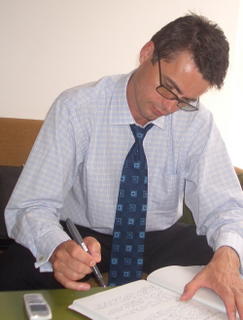Monday, October 30, 2006
Dealing with bicycle congestion - not Sydney
Copenhagen the 'City of Cyclists' with 33% of daily commuter trips to the CBD on bicycle - compared to 2% in Sydney (our bicycle plan aims to increase that to 10% by 2016). Copenhagen's cycling planners deal with challenges that do not confront Sydney's transport planners - yet. When eCouncillor visited Copenhagen Town Hall for a day and cycled around the city with the planners including Troels Andersen as they pointed out their difficulties including bicycle congestion at intersections, parking and balancing the right of way at key intersections. The congestion problem was causing the Council to widen major cycle lanes on some of Europes busiest bicycle lanes. In addition new lights separating out bicycle movements from other cars at intersection are installed in most locations. News today (below) that new 'green wave lanes' are being installed to assist with the smooth flow of bikes. 'Waves' have been trialed on Odense and were very successful. Sydney's not ready for them yes but maybe in 2020.
Cyclists riding a green wave A string of synchronised green lights promises to cut travel times on one of Europe's busiest bike lanes
Cyclists travelling along one of Copenhagen's most congested thoroughfares can now say goodbye to red lights and the stop-and-go of rush hour traffic. City officials unveiled the first 'green wave' lane for bikes in the Nørrebro neighbourhood Wednesday.
The green wave bike line times eleven traffic lights to match bicyclists average speed. Travel times on the 2.5 km stretch are expected to be reduced by three minutes.
Reducing travel time makes sense, according to civil engineer Troels Andersen, but the psychological effect of not constantly seeing red is even more important.
'If cyclists have to stop at every traffic light, they get fed up and feel unappreciated. In the worst case, they make the switch to cars,' he told daily newspaper dato.
A 'green wave' sign with a cyclist logo helps direct two-wheeled commuters from side streets to their express lane.
As morning traffic streams into the city, the green wave flows toward central Copenhagen. From noon until 6pm, the wave shifts directions and gives cyclists a speedy exit out.
Some 30,000 cyclists are expected to benefit from the system every day. Klaus Bondam, deputy mayor for environmental affairs, hopes the path will cement the Copenhagen as the world capital of commuter cycling.
'Copenhagen is going to be the world's best cycling city. And Nørrebrogade is probably one Europe's busiest bike lanes,' said Bondam.
The new lane requires cyclists to adjust their biking habits, however, according to Harry Lahrmann, a traffic researcher at Aalborg University.
'In order for a green wave to work, cyclists will have to ride at basically the same speed as everyone else. That's probably more difficult than for cars. A number of cyclists race ahead at 25 km per hour, so they won't get much out of the lane.'
Motorists, meanwhile, will have to grow used to the sight of cyclists overtaking them in rush hour traffic.
The Copenhagen Post
Subscribe to:
Post Comments (Atom)

No comments:
Post a Comment